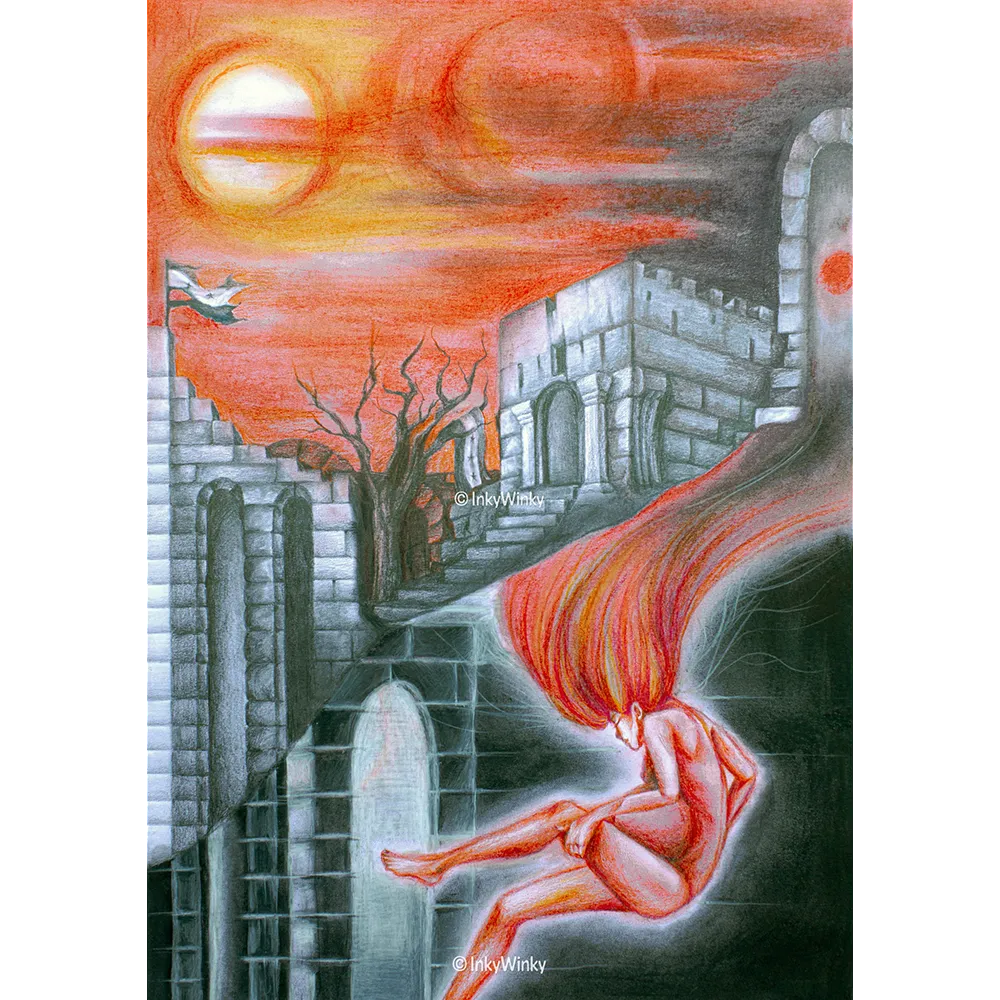What Other Medium Is Popularly Used with Charcoal?
Charcoal art often synergizes with other artistic mediums, creating dynamic and multifaceted pieces. Some popular combinations include:
- Graphite Pencil: Charcoal and graphite complement each other so well it's as thought they were made to go together. Artists often use graphite for precise details and fine lines, while charcoal adds depth and expressive strokes. Graphite also adds a reflective polished appearance to the artwork, while charcoal tends to create more of a matte surface. Combining both mediums give the artist incredible control over the way that light interacts with their artwork.
- Ink: Combining charcoal with ink, either through pen and ink or ink wash techniques, allows artists to create intricate and textured drawings. The contrast between the boldness of charcoal and the precision of ink can result in visually striking compositions.
- Pastels: Charcoal and soft pastels work harmoniously to create rich and vibrant artworks. Pastels can be applied over charcoal to introduce color, enhancing the overall visual impact without losing any of the benefits of using charcoal.
- Watercolor: Charcoal and watercolor can create a beautiful contrast between the bold, dark lines of charcoal and the transparent, fluid nature of watercolor. Combining both forms via layering creates an expressive and dynamic quality to the artwork. Typically artists will use watercolor to set the background with the charcoal added towards the end of creating to define the shadows and foreground.
- Acrylic or Oil Paint: Charcoal underpainting is a technique where artists use charcoal as a base layer before applying acrylic or oil paint. This method adds texture and depth to the final painting, with the charcoal subtly influencing the overall composition.
- Mixed Media Collage: Charcoal works seamlessly within mixed media compositions. Artists may incorporate elements like newspaper clippings, fabric, or found objects, combining diverse materials for a layered and textured effect.
Artists often experiment with many different combinations to push the boundaries of their creativity, resulting in unique and innovative artworks that blend traditional and contemporary techniques.
Historically, Where Did Charcoal Come From?
Charcoal has a rich historical background, with its origins dating back thousands of years. The use of charcoal as a drawing medium can be traced to ancient civilizations, where early humans employed burnt sticks to create drawings on the walls of prehistoric caves. This primal form of artistic expression serves as the earliest evidence of charcoal's role in the creative process.
In ancient Egypt, charcoal found widespread use for both artistic and practical purposes. Artists utilized charcoal to craft detailed sketches and drawings, while it also played a crucial role in the creation of papyrus manuscripts. However, unlike other ancient drawing mediums, charcoal never fell out of favor. Moving forward in history, during medieval times, charcoal became integral to the production of illuminated manuscripts. Scribes used it for initial sketches and underdrawings, providing a foundation for the intricate and colorful pigments that would follow.
The Renaissance marked a significant period for charcoal in the art world. Renowned artists like Leonardo da Vinci and Michelangelo extensively used charcoal for their studies and preparatory sketches. The medium's versatility allowed for detailed anatomical drawings and expressive sketches. Throughout the centuries, charcoal has retained its prominence, becoming a cherished medium appreciated for its historical significance and timeless capacity to capture the essence of artistic vision.
What Kind of Emotions Does Charcoal Art Evoke in the Viewer?
Charcoal art has the power to evoke a wide range of emotions in viewers due to its expressive and versatile nature. Some common emotional responses include:
- Intimacy The tactile quality of charcoal strokes can create an intimate connection between the artwork and the viewer. The raw and unpolished nature of charcoal drawings often elicits a sense of closeness and authenticity.
- Melancholy: Charcoal's ability to create deep, shadowy tones can evoke a sense of melancholy or contemplation. Artists often use this quality to convey emotions associated with introspection or thoughtful reflection.
- Drama and Intensity: The bold contrasts achievable with charcoal, particularly in chiaroscuro (light and shadow) techniques, can infuse a sense of drama and intensity. This can create a visually gripping experience that resonates emotionally with the viewer.
- Timelessness: Charcoal's use in both traditional and contemporary art can give a sense of timelessness. Viewers may experience a connection to the past through the same medium that artists have used for centuries, fostering a sense of continuity and cultural richness.
- Expressive Energy: The loose and dynamic strokes created with charcoal often convey a sense of energy and spontaneity. This can evoke emotions associated with movement, passion, or the immediacy of the artistic process.
- Mystery and Atmosphere: Charcoal's ability to create soft, atmospheric effects with it's broad strokes, can imbue a sense of mystery and intrigue. Viewers may find themselves drawn into the artwork, contemplating the narratives or emotions suggested by the subtle play of light and shadow.
Ultimately, the emotional impact of charcoal art is subjective and can vary widely depending on the individual viewer's experiences, perceptions, and interpretations. Charcoal's unique qualities contribute to its ability to evoke a visceral and emotional response from those who engage with the artwork.



















